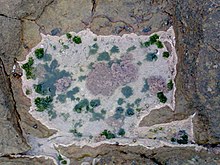This article has multiple issues. Please help improve it or discuss these issues on the talk page. (Learn how and when to remove these messages)
|

A microclimate (or micro-climate) is a local set of atmospheric conditions that differ from those in the surrounding areas, often slightly but sometimes substantially. The term may refer to areas as small as a few square meters or smaller (for example a garden bed, underneath a rock, or a cave) or as large as many square kilometers. Because climate is statistical, which implies spatial and temporal variation of the mean values of the describing parameters, microclimates are identified as statistically distinct conditions which occur and/or persist within a region. Microclimates can be found in most places but are most pronounced in topographically dynamic zones such as mountainous areas, islands, and coastal areas.[1]
Microclimates exist, for example, near bodies of water which may cool the local atmosphere, or in heavy urban areas where brick, concrete, and asphalt absorb the sun's energy, heat up, and re-radiate that heat to the ambient air: the resulting urban heat island (UHI) is a kind of microclimate that is additionally driven by relative paucity of vegetation.[2]
- ^ Ellis, C. J.; Eaton, S. (2021). "Microclimates hold the key to spatial forest planning under climate change: Cyanolichens in temperate rainforest". Global Change Biology. 27 (9): 1915–1926. Bibcode:2021GCBio..27.1915E. doi:10.1111/gcb.15514. PMID 33421251. S2CID 231437285.
- ^ Camus, John (November 12, 2017). "6 Examples of an Urban Microclimate". Sotoga. Archived from the original on Sep 2, 2023.